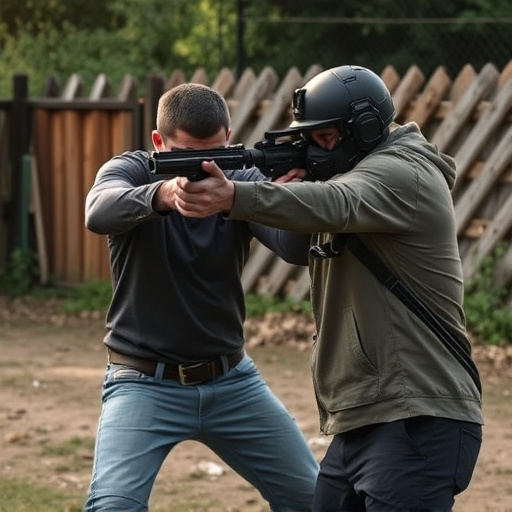Obtaining and maintaining Stun Gun Certification involves theoretical learning, hands-on training, and regular practice. Monthly maintenance tips include cleaning, inspecting, lubricating, and storing stun guns properly to ensure optimal performance and certification eligibility. Regular care prevents damage, corrosion, and wear, extending the lifespan of the device. Following these stun gun monthly maintenance tips is crucial for reliability and safety in emergency situations.
“In today’s world, non-lethal self-defense tools like stun guns offer individuals a powerful means of personal safety. This comprehensive guide delves into the essential aspects of stun gun training and certification, providing valuable insights for responsible ownership. We explore eligibility criteria, emphasizing the importance of regular maintenance for optimal performance. From monthly care routines to common pitfalls, this article equips readers with expert tips, ensuring they make informed decisions regarding stun gun acquisition and upkeep, including practical advice on stun gun monthly maintenance tips.”
- Understanding Non-Lethal Weapon Training Certification
- Eligibility Criteria for Stun Gun Certification
- The Importance of Regular Maintenance for Stun Guns
- Step-by-Step Guide to Stun Gun Monthly Maintenance
- Common Mistakes to Avoid During Stun Gun Care
- Benefits and Limitations of Non-Lethal Self-Defense Tools
Understanding Non-Lethal Weapon Training Certification

Non-lethal weapon training certification is a crucial step for individuals seeking to master and deploy less-lethal force tools responsibly. This process equips users with the knowledge required to handle and operate devices like stun guns effectively while minimising the risk of severe injury or death. The certification typically involves theoretical instruction, hands-on training, and regular practice sessions designed to ensure proficiency in every aspect of non-lethal weapon deployment.
One key component often included in this training is stun gun monthly maintenance tips. Users learn how to clean, inspect, and maintain their devices to keep them in optimal working condition. This routine care not only extends the lifespan of the equipment but also guarantees maximum reliability during critical situations. Understanding proper maintenance procedures is as vital as knowing how to use the weapon, ensuring its effectiveness when it matters most.
Eligibility Criteria for Stun Gun Certification

To be eligible for a Stun Gun Certification, individuals must meet specific criteria set by reputable training institutions and regulatory bodies. Typically, applicants should be over 18 years old, possess a valid government-issued ID, and pass a background check to ensure they have no significant criminal record. It’s essential to demonstrate a basic level of physical fitness and mental capability, as the training may involve hands-on practice with the stun gun device.
Regular stun gun maintenance is crucial for ensuring its optimal performance when needed. Monthly maintenance tips include checking the battery level, cleaning the device with a soft cloth, inspecting for any signs of damage or wear, and lubricating moving parts as per the manufacturer’s instructions. Proper storage in a secure location, away from children and unauthorized individuals, is also vital to maintain certification eligibility.
The Importance of Regular Maintenance for Stun Guns

Regular maintenance is essential for keeping stun guns in optimal working condition, ensuring their reliability and safety. Stun guns, like any other electrical device, require routine care to prevent performance issues and prolong their lifespan. Users should aim to perform a simple check and clean at least once a month. This involves inspecting the weapon for any signs of damage, corrosion, or wear and tear, especially around the contacts and battery compartment.
Following stun gun monthly maintenance tips can include wiping down the device with a damp cloth to remove fingerprints and grime, ensuring all components are tightly secured, and checking the battery’s health. It’s also crucial to keep the stun gun stored in a dry, cool place, away from direct sunlight and extreme temperatures, to maintain its performance and extend its certification validity period.
Step-by-Step Guide to Stun Gun Monthly Maintenance

Maintaining your stun gun regularly is essential for ensuring its reliability and safety. Here’s a step-by-step guide to help you with stun gun monthly maintenance tips:
1. Inspect the Device: Start by thoroughly examining the stun gun for any visible signs of damage, corrosion, or wear. Check all connections, triggers, and safety mechanisms. Ensure that the device is in good working condition before proceeding.
2. Clean the Exterior: Use a soft, dry cloth to wipe down the exterior of the stun gun. Remove any dirt, dust, or fingerprints. Avoid using harsh chemicals or water as it might damage the device. For stubborn marks, use a mild cleaning solution specifically designed for electronics.
3. Check Battery Level: Regularly inspect the battery level to ensure it’s fully charged. Most stun guns come with a low-battery indicator. Replace the batteries if they’re old or show signs of weakness. Remember, stun guns rely on reliable power sources to function effectively.
4. Lubricate Moving Parts: Apply a small amount of high-quality lubricant to any moving parts, such as triggers and safety switches. This helps maintain smooth operation and reduces friction, which can lead to malfunctions over time. Make sure the lubricant doesn’t get into non-lubricated areas.
5. Test the Device: After completing the maintenance steps, test the stun gun in a safe, controlled environment. Check all functions, including power, output, and the trigger’s responsiveness. This ensures that everything is working as intended and allows you to identify any potential issues early on.
Common Mistakes to Avoid During Stun Gun Care

When it comes to stun gun care, there are several common mistakes that individuals often make. One of the most crucial aspects is neglecting regular cleaning and maintenance, which can lead to a buildup of grime and bacteria on the device. Stun guns require meticulous care to ensure their effectiveness and longevity. Users should adopt a disciplined routine for stun gun monthly maintenance tips, including deep cleaning with recommended solutions and wiping down after each use.
Another mistake is improper storage. Stun guns should be kept in secure, designated locations, away from children and unauthorized individuals. They must be stored in protective cases or holsters to prevent damage and maintain optimal performance. Always follow the manufacturer’s guidelines for charging and battery maintenance. Neglecting these simple yet vital stun gun care practices can compromise the weapon’s functionality when it’s needed most.
Benefits and Limitations of Non-Lethal Self-Defense Tools

Non-lethal self-defense tools, such as stun guns, offer a range of benefits for personal safety and security. These devices are designed to incapacitate an assailant temporarily without causing serious harm, providing users with a valuable option for self-defense in various situations. Stun guns are compact, easy to use, and can be carried discreetly, allowing individuals to feel empowered and prepared when facing potential threats. Their effectiveness lies in delivering a powerful electrical shock that disrupts muscle control, enabling the user to escape or deter an attacker.
However, it’s essential to acknowledge certain limitations. Regular maintenance, including stun gun monthly maintenance tips, is crucial to ensure optimal performance. Battery life, for instance, needs attention to prevent malfunctions. Additionally, while non-lethal weapons are effective in many cases, they may not always render an assailant completely unconscious or incapable of fighting back immediately. The level of force used should be proportionate to the perceived threat, and users must understand their legal responsibilities when carrying and using such devices, as regulations vary across regions.
Obtaining a non-lethal weapon training certification, such as stun gun certification, equips individuals with valuable self-defense skills. Regular stun gun maintenance, including adherence to stun gun monthly maintenance tips discussed in this article, is crucial for ensuring reliability and optimal performance. By understanding eligibility criteria, common care mistakes to avoid, and the benefits and limitations of non-lethal tools, you can confidently protect yourself while adhering to best practices in self-defense preparation.
